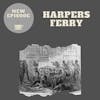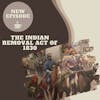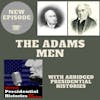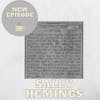Harpers Ferry

Often classified as a dress rehearsal for the Civil War, the raid on Harpers Ferry was a watershed moment in American History.
Fully believing his purpose in life was to end slavery, John Brown put together an ambitious, and some would argue unattainable, plan to initiate a war pitting slaveholders against the men and women they held in bondage.
While Brown's plan failed, the implications ricocheted throughout the country, further dividing the nation. Tune in this week to find out what happened and why it was such a pivotal moment in history.
SOURCES
Bordewich, Fergus. “John Brown’s Day of Reckoning.” Smithsonian Magazine. October 2009. (LINK)
Finkelman, Paul. “A Look Back at John Brown.” Prologue Magazine. National Archives. Vol. 3, No. 1. Spring 2011. (LINK)
“Harpers Ferry Headline.” Africans in America. PBS. (LINK)
Howard, Victor B. “John Brown’s Raid at Harpers Ferry and the Sectional Crisis in North Carolina.” The North Carolina Historical Review 55, no. 4 (1978): 396–420. http://www.jstor.org/stable/23534921.
“John Brown’s Raid.” National Park Service. Updated June 9, 2022. (LINK)
Moore, Rayburn S. “John Brown’s Raid at Harpers Ferry: An Eyewitness Account by Charles White.” The Virginia Magazine of History and Biography 67, no. 4 (1959): 387–95. http://www.jstor.org/stable/4246574.
Schurr, Nancy. “John Brown's Raid on Harper’s Ferry.” 2018. Retrieved from the Digital Public Library of America. (LINK)
“The raid on Harpers Ferry.” Africans in America. PBS. (LINK)
“I have only a short time to live - only one death to die, and I will die fighting for this cause.” John Brown, August, 1856.
Welcome to Civics and Coffee. My name is Alycia and I am a self-professed history nerd. Each week, I am going to chat about a topic on U.S history and give you both the highlights and occasionally break down some of the complexities in history; and share stories you may not remember learning in high school. All in the time it takes to enjoy a cup of coffee.
INTRO MUSIC
Hey everyone, welcome back.
Under the cover of darkness in October, 1859, well known abolitionist and agitator John Brown prepared himself and his small army to strike a fatal blow to slavery. The plan was simple: infiltrate a federal armory and disperse weapons to enslaved men and women who would take up the cause of their freedom. However, the plan did not go as expected and less than 36 hours after the siege began, Brown and his remaining comrades would be in custody.
The raid on Harpers Ferry is seen by many historians as one of the pivotal events leading to the Civil War. While a brief skirmish that failed in almost every planned objective, the aftermath of Harpers Ferry proved to be the linchpin for southerners and northerners alike, further separating an already divided nation.
This week, I am diving into the raid on Harpers Ferry. What happened? Who was involved? And why do so many consider it a pivotal moment in the run up to the Civil War?
Grab your cup of coffee, peeps. Let’s do this.
Before we dive into the raid and its implications, let’s start with a primer on the mastermind behind the events, John Brown. If you’ve been a longtime listener of the show, then you’ve likely heard me mention Brown as a prominent, militant abolitionist who was respected by black Americans such as Harriet Tubman and Frederick Douglass.
Born on May 9, 1800 in Connecticut, Brown was immersed in the fight to protect others from childhood. Growing up in a deeply religious family with strong abolitionist views, Brown learned early about the ills of slavery. When he was five, the family moved to the quote unquote frontier in Ohio where his father became an active member of the Underground Railroad and was a known ally of local indigenous groups. Calvinist in his beliefs, Brown believed sincerely that his purpose in life was to combat slavery.
As a young man, Brown briefly considered becoming a member of the clergy, even journeying back to Connecticut to attend a prep school, but quickly changed his mind marrying his first wife Dianthe Lusk in 1820. Together, the couple had seven children, five of which would live into adulthood. After his first wife died in 1832, Brown remarried, this time to 16 year old Mary Ann Day, in 1833. Day would go onto give birth to a whopping thirteen children, only 6 of whom made it to adulthood.
Brown tried his hand at several careers, including as a postmaster, tanner, and land developer. Unfortunately, Brown - like many others in this period - was not an astute businessman and went through a series of booms and busts, before declaring bankruptcy in 1842. He developed relationships with prominent abolitionists like Gerrit Smith during this same time period, and while a staunch supporter of the abolitionist cause, was not a prominent member within the community.
The 1850s seemed to be the decade that pushed Brown from ardent supporter to activist as the country inched its way closer toward war. Like many abolitionists, Brown was angered over the Fugitive Slave Act of 1850, but became particularly incensed over the events happening in Kansas as the result of the Kansas-Nebraska Act. Brown moved into the territory with his son in 1855 and aided in defending Lawrence for pro-slavery forces that winter. In 1856, while Brown was away, slavery supporters invaded the town, burning it to the ground. Just a few days later, Brown returned and exacted his revenge. In an act of true vigilante justice, Brown and several men murdered a handful of settlers, decapitating them. The territory was in the midst of extremely violent conflict, which would later play into its moniker of Bleeding Kansas.
This seemed to propel Brown into the forefront of the abolitionist movement and he was equally celebrated and hated, depending on which side of the slavery debate one was on. The murder of five southern settlers even prompted a Broadway play, which painted Brown in a much different light, going as far as to claim that Brown was innocent of murder and was being falsely accused. Brown also initially denied his involvement in the murders, likely trying to assuage any concerns of Northern supporters with big pockets whose money he would rely on to fund his war against slavery.
The plans for the raid were years in the making, with some claiming Brown had started ruminating over the idea as early as 1854. The idea behind the plot was to instigate a war in the south, providing aid and weapons to enslaved individuals who, in turn, would rise up and join the swelling ranks to override their oppressors. In order to have sufficient munition on hand, Brown chose Harpers Ferry, home to a federal arsenal and Rifle Works, a major supplier of ammunition for the government. With roughly four million people held in bondage, Brown felt strongly there would be more than enough support and able bodied men available to help strike the final nail in slavery’s coffin.
While a grandiose plan, many believed Brown would not be successful. When he tried to convince his friend and fellow abolitionist Frederick Douglass to join the group, Douglass refused, telling Brown that he was walking into a trap and he would quote “never get out alive” end quote.
Regardless of the odds stacked against him, Brown continued to map out his assault, traveling throughout the north east to raise the necessary funds. Once he had the supplies he needed, Brown, along with 21 others, rented a farmhouse just across the river from Harpers Ferry in July, 1859. Hoping to avoid suspicion, the members of the small militia group stayed in the attic, only coming out after dark to avoid detection. Brown even had his daughters come stay on the property to help keep up the ruse and they assisted their family by cooking and cleaning up after the hordes of men staying on site. The farm acted as a training camp and at night, the men would prepare themselves for the upcoming battle. Wanting to ensure his daughters were safe and aware from harm, Brown sent them back to New York just a few weeks before he launched his attack.
Finally, Brown gave his command, telling his followers quote, “men get on your arms; we will proceed to the ferry” end quote. Leaving their base of operations at 8 o’clock in the evening on October 16, 1859 Brown and his small militia made their way toward Harpers Ferry. The cut telegraph lines, secured the two bridges leading into the area, and overtook the railroad depot before capturing the federal armory, then the arsenal, and finally the Rifle Works. He then sent his men to capture two prominent enslavers, one of which was a descendant of first president George Washington, and captured sixty other hostages, telling them he had come to liberate the black men and women in their state and was willing to execute anyone who get in his way. While Brown hoped that his actions would prompt a swift uprising within the slave community, he would be disappointed.
Instead, word quickly spread about an attempted invasion, made all the worse thanks to the sensational headlines that were so common during this period. One northern headline claimed there was a quote “extensive negro conspiracy” end quote. This, despite the fact that Brown had just two black men in his charge. However this headline was what every southern slaverholder had been worried about for years. Astutely aware of the millions of men and women held against their will, southern slaveholders were always on the lookout for potential slave uprisings. Now, with that one headline, their worst fears had come true.
The truth of the matter was that despite being devout in his beliefs, John Brown’s planned assault was… misguided at best, and delusional at worst. Given his religious faith, Brown strongly believed that he was put upon the earth to deal the final blow to slavery and so I guess, under this framework, going into hostile territory with minimal weapons and even fewer committed soldiers may have felt like fulfilling God’s purpose, but it still seems that Brown had not fully considered the ramifications of his actions.
Because, despite his fervent devotion, things deteriorated quickly and less than 36 hours after his invasion, Brown would be under arrest and facing charges. As word spread throughout the area, gangs of men formed ad hoc militias, committed to defending their territory and, by extension, their way of life. And, without the reinforcements Brown had hoped for, he and his men were sitting ducks, quickly forced to barricade themselves in the engine house. Back in Washington, President Buchanan learned of the events at Harpers Ferry due to a train conductor who had been headed toward Baltimore.
As I covered during his episode, Buchanan had strong southern sympathies and felt that abolitionists were only instigators aching for a fight. He sent a small unit of Marines, led by the soon-to-be-famous Robert E. Lee, to put an end to the invasion. Going without food for 24 hours, Brown and his men were in no position to put up a fight and, seeing that the end was near, attempted to negotiate a ceasefire. He initially sent someone out under a white flag of truce, but they were quickly captured. He followed up by sending his son Watson, who was shot and mortally wounded.
The surrounding forces eventually made their way inside the engine room and upon setting their eyes upon the abolitionist leader, one militiamen launched at Brown, saber out and plunged it straight into Brown’s gut. By some miracle, the saber hit a belt buckle and Brown survived the encounter unharmed. He was, however, taken into custody, along with five others, and charged with treason, first degree murder, and conspiring to produce an insurrection. His trial was set for October 26th in Charlestown, Virginia and I think it will surprise no one to learn he was found guilty and sentenced to death by hanging. Just a few weeks after his conviction, the 59 year old John Brown made his way toward the gallows, apparently telling his escort quote: “Don’t keep me waiting longer than necessary. Be quick,” end quote. Those would be his final words.
In death, John Brown became a martyr for his supporters and further divided the fractured country. To northerners, Brown was a man who died for a worthy cause. For southerners, he represented tyranny. In fact, one southern newspaper cast the raid in the extremist possible light, writing in part that the quote “invasion has advanced the cause of disunion more than any other event that has happened since the formation of government” end quote.
For the south, the raid of Harpers Ferry was proof positive that radicalized abolitionists were hellbent on destroying the country. It increased their paranoia, leading to the establishment of several vigilance committees tasked with rooting out any abolitionist activity. Convinced they would be invaded again, several southern residents formed their own militia groups and began training - something that, as it turns out, would prove helpful as the country entered war just over a year later.
Considered a dress rehearsal for the Civil War, historians have long pointed to Harpers Ferry a moment that forever altered the trajectory of the country. Some speculate that without John Brown and his raid, Lincoln may not have been elected in 1860. The raid was so polarizing, causing a rift within the Democratic party and paving the way for third party candidates. These candidates were pivotal in Lincoln’s victory as he only captured 40% of the popular vote. While it is impossible to know for sure, there is a strong argument that in his own way, John Brown struck the match that would burn slavery’s palace to the ground.
A man whose goals were larger than his resources, John Brown’s raid on Harpers Ferry proved to be a watershed moment in American history. An event that certified once and for all the issue of slavery could not be handled with compromise or legislative action, the siege in Virginia set the stage for what would become the bloodiest conflict in the nation’s history and lead to the eventual downfall of that peculiar institution.
If you’ve been enjoying the podcast, please consider a rate and review. Goodpods, Spotify, Podchaser, Apple Podcasts - your options are endless. Your five star reviews help get the podcast out to the masses and you know they definitely make my day. To learn more about the source material, transcripts, or other ways you can support the show, head over to the website at www dot civics and coffee dot com.
Thanks, peeps. I’ll see you next week.
Thanks for tuning and I hope you enjoyed this episode of Civics & Coffee. If you want to hear more small snippets from american history, be sure to subscribe wherever you get your podcasts. Thanks for listening and I look forward to our next cup of coffee together.
OUTRO MUSIC
Listener Favorites
Not sure where to begin? Take a listen to some fan favorites.

























